#milgram theory
Explore tagged Tumblr posts
Text
The square key is still missing...


So that has to be Es' key, right? After all, it's right in the center of their collar.

233 notes
·
View notes
Text
futa t3 analysis and predictions yeah baybee

So let's talk about his sprite. As he's been "completely brainwashed" there's hardly any semblance of self left in the subject. He is but a devoted follower, with characteristics (hoodie, sweatpants) fully gone. The things he says are hardly what he could ever phathom before. Truly a victim of a cult. But is he fully gone?


First things first and the most obvious, his eye. From what we see in Purge March, we could assume the cult that kept Amane wouldn't really care about covering up injuries since "anything happens because of God" or whatever, right. Why is he covering himself then? Something Futa is used to do, covering up weaknesses and things he feels insecure about. Even the shirt he got isn't fully fit like those types of shirts tend to be worn (specially in such a Church Boy type of outfit), in fact it resembles the one he wears under his hoodie in Jihen Joutou, same length and everything.

There's also his shoes and socks, which could mean nothing, but I'm going to be insane and say they do. The soles of these shoes are very particular for this type (see Amane's, hers are very formal and have plain soles). And, as funny as the horrid socks are, they are also the one thing that has remained consistent across all of Futa's designs every trial and even his T1 MV.
And lastly, the way his voice actually sounds. Even though his speech is different, his intonation and general expression is the same as always. He sounds upset and even pained? At least when I compare it to other scenes where he is visibly upset. And most importantly, in all his speak of salvation, he does repetition at least 3 or 4 times. Where did we see this before... (T1 voice drama. when he's denying having killed. he repeats it 4 times).
So we have remnants of himself in his clothing (coverage of insecurities, returning and consistent pieces of clothing, things that clash with the blank slate cult follower image) and his speech (tone of voice and repetition hints)
Where I'm going with this: The religious mindset will most likely falter in his voice drama. As I've said before with Futa, he not only is someone unable to commit to things fully for fear of it failing him, when he does it does fail him and he is left hopeless all over again. His mom, his friends... He does anything he can to find solace in whatever will grant him it. For now it's Amane, but is it really a strong a foundation as they want us to believe? Amane grew up with it. She was tortured into following. Futa was just vulnerable, which isn't new to him. Are these little details of his "old" self indicative that his faith will crumble the moment Es challenges it?
But hey, I didn't write him. So we'll see!
153 notes
·
View notes
Text
A very very wild crack theory: Maybe they're Muu's parents?


Alright, so I saw this tweet long time ago, and I was wondering what could possibly happen between Muu and Kazui in T3, like it's gotta be intentional right??
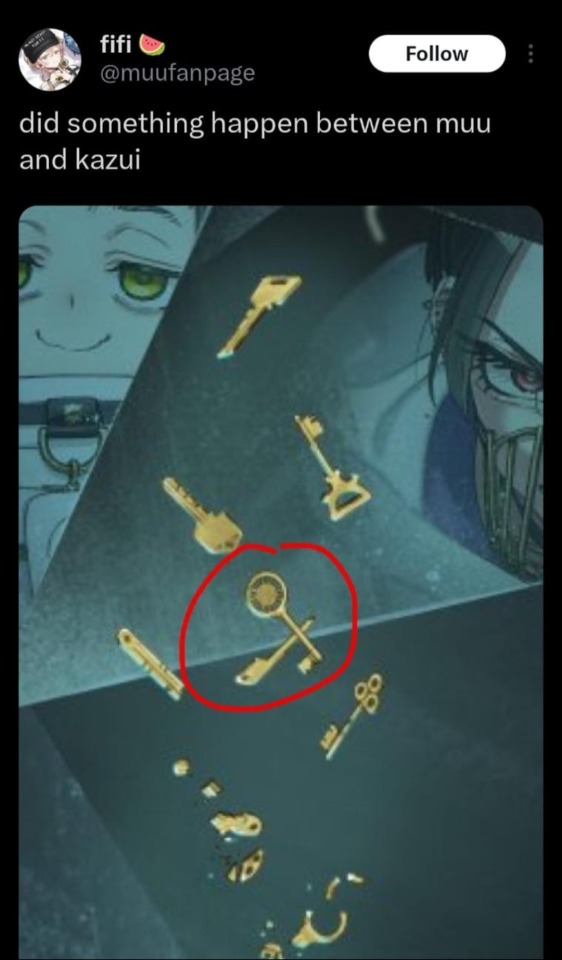
Not to mention in Kazui's bday art his watch is now gold and there's bee in it🐝

How did I come up with that theory? Well it's just that the bartender is always associated with gold, example, his wedding ring, his pins and the ornaments (?) at the bar, so I think it has something to do with him


Although I don't really want it to be taken seriously because it's a crack theory.. I think there's still possibilities
In both novelgram prisoners have connections/know each other, so i think it's not too far fetched to theorize about this and it'd be cool if MILGRAM do the same
Muu doesn't seem to know much about her dad. When answering questions about him, she always says "I think" she's unsure about it. Also guys Muu literally said her dad has multiple jobs. In Kazui's first birthday TL, he said that his friend doesn't live close to him and he rarely meets them. It's possible he doesn't know what his friend's daughter looks like.
Uhh starting with, Muu and bar lady have the same eyelashes



But wait their hair color are different though?? I have explanations for this, naturally blonde hair usually darkens as you age. This is why blonde hair is much more common in babies than adults. There's also another factor, which is hormonal changes especially during puberty (which means Muu is quite lucky lol), pregnancy etc. can affect melanin production. Your hair can even go blonde to brown because of this. Also I know that MILGRAM itself is very animek but like we see Mikoto's hair dyes fade during T2, besides Muu is the only prisoner with colored eyelashes instead of black eyelashes like other prisoners (like in their sprites y'know) and in Crying B, Es said that Muu must've stands out a lot (Idk Es there's literally a guy who has blue hair)
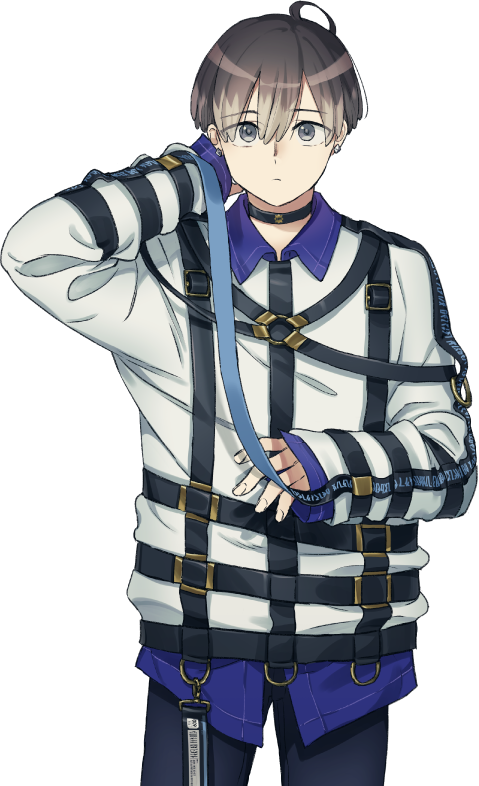
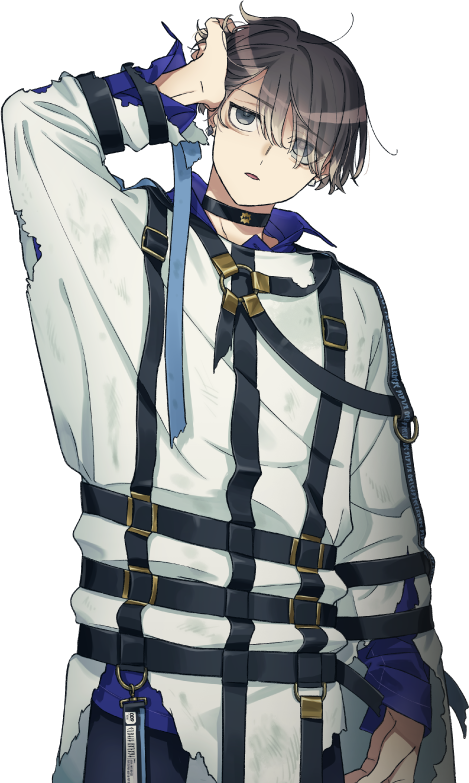

BTW you guys ever wondered about the wedding topper on Kazui's bday art?? Like why is the bride blonde? Well I think it might be the bar lady because I color picked and compared them and it's just few shades darker, which fits with this theory
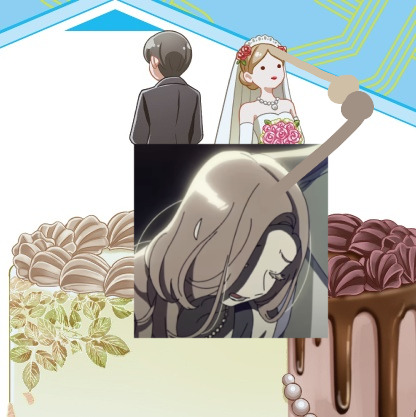
Based on Muu's guess about her dad's age, it can be said that her parents married at a pretty young age considering in 2000s the average age of first time marriage for Japanese guy was 28/29

Next up, do you know that the cocktail she's having is called Manhattan? Which is known as the queen of cocktails dunno if this is just JP thingy or not. Meanwhile Muu T2 VD is called Queen B, crazy coincidence (sad fact about Manhattan though, in JP, cocktail language for Manhattan is "Heartrending love" or "Love that brings you pain")



"Import foreign furniture from overseas" chair in Half maybe? I'll elaborate the chair in half has Fleur de lis. Though I wouldn't count it as a proof due to the image quality


But welll Kazui's mask has Fleur de lis and Muu has it on her bday (obviously)

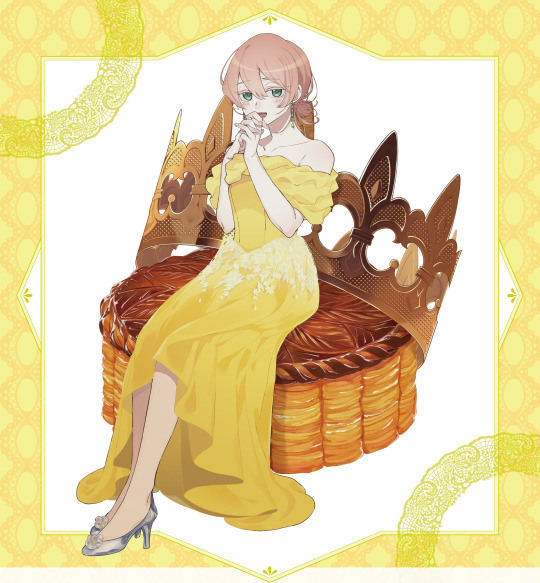
And Muu said that her dad might be a landlord, that reminds me, Kazui and Hinako live in an apartment right?
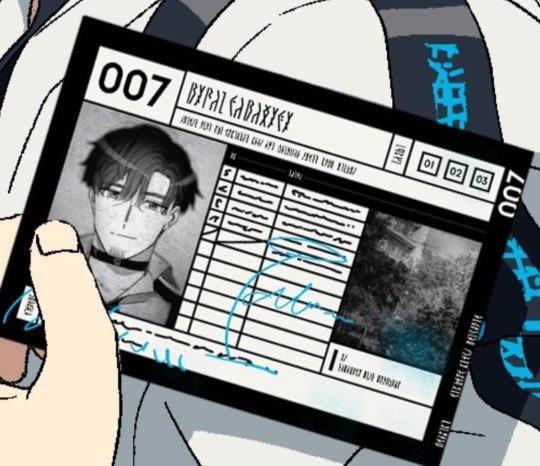
Muu's hobby is taking care of tropical fish, meanwhile Kazui's childhood friend hobby is fishing coincidence or coincidence (don't remember the TL so I use his interro instead)


Oh yea back to the wedding topper, I feel like the tailcoat tuxedo resembles a fish tail because large gaps(?) like that is pretty uncommon for a tailcoat tuxedo so I think it's on purpose idk. The bride wears a pearl necklace anyway what I'm saying is that all are related to sea

In Muu's T2 sprite we see her wearing gold shell earrings, which is again related to sea

And like Muu's mom is from Nice, France, that place is famous for its ocean and beach. Heck even Muu said it herself. This is MILGRAM guys even the place they chose have a reason for it, for example Muu lives in Minato, it has a high cost of living and do you guys know more than 10% of Minato’s total population is foreigners? Like they can chose something generic like Paris but they chose Nice specifically
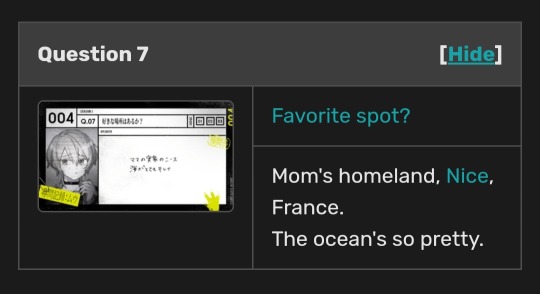
Lastly, I've seen ppl mention about the missing ring in Half but guys Bartender usually take off their wedding ring so it wouldn't get lost/damaged when bartending

I think that's all thank you for listening to my yapping session🙏🙏 Also about the location I don't really think it's really a problem because adult don’t necessarily live close to each other… especially since Kazui use birthday to have an excuse to contact them yk

#milgram#muu kusunoki#kazui mukuhara#milgram theory#milgram project#half milgram#cat milgram#wild theory#Really love the NPCs in half you guys won't understand#Do you know that the 2nd drink she had is tequila sunset which means “Comfort me” and “Passionate love”#ATLEAST EXES OR WHATEVER I DON'T MIND😭🙏
97 notes
·
View notes
Text
deep cover thoughts, or: who is kotoko's victim, really?
ok. so now that we've seen the deep cover mv, it's late but before i go to bed i want to post my biggest thought/theory on it. that being?
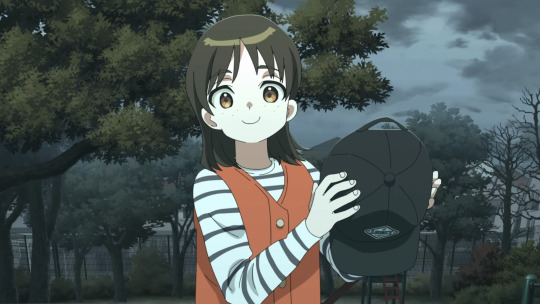
this girl is the victim that kotoko is in milgram for, and the murder we see in the warehouse is a red herring.
now. one thing about the prisoners that are grouped together is that each duo appears, largely, to have a direct murder and an indirect murder in it.
haruka is seen directly killing in his mvs; yuno's murder is an abortion, something so indirect many people don't even consider it to be such. muu is clearly seen directly stabbing rei in her mvs; fuuta's victim dies indirectly due to him starting online backlash against her. whatever shidou is doing to his patients appears to be pretty direct, while mahiru's boyfriend seems to have died indirectly due to having killed himself. kazui is in the same indirect boat as mahiru with hinako's apparent suicide; meanwhile amane is shown in purge march to have directly attacked and killed her mother.
with one duo, up until now, having been an apparent exception.
we can see these groupings clearly in the first anniversary art with all the prisoners together:

all the direct murderers are on one side of the table, and their indirect counterpart on the other. all the patterns outlined above, we can see here.
mikoto is on the direct murderers' side of the table, and this makes clear sense with what we see in MeMe's opening shots: as vague as mikoto's mvs can be sometimes, we definitely see him hit that guy with the baseball bat pretty explicitly.
and kotoko? kotoko, as his counterpart, is on the indirect side of the table. this seemed weird, because from what we knew of her murder in harrow... we see her track a guy down into a warehouse and kill him pretty directly. it seems like these two are an exception. but now, we have deep cover, and... are they really both in milgram for a direct murder?

it seems like something bad is happening in this shot, judging by the girl's expression. what do we see right after? kotoko leaving this girl behind, walking past her. she's looking for her next target, and she doesn't have time to play around right now. only... i think it goes wrong. i think kotoko leaving this girl when she does is a mistake, and that her disregard for the girl leads to her getting hurt and dying somehow. after all... the images on the prisoner cards appear to correspond to the murder location. and kotoko's...

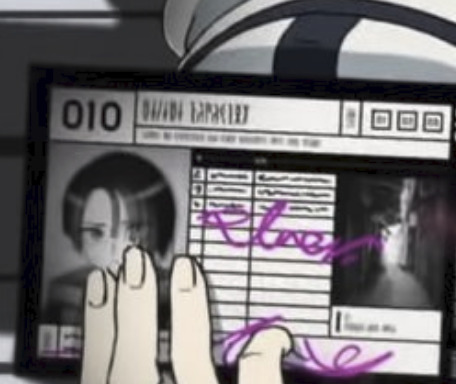
kotoko's looks an awful lot more like this than it does like that warehouse.
it seems like this girl idealizes kotoko an awful lot for having saved her. maybe she tries to follow kotoko, but something happens. maybe she gets caught by whoever it is that kotoko is trying to hunt down... and maybe this time, she doesn't make it out okay.
543 notes
·
View notes
Text
A little speculation about Corpse Disposal and J-horror
But I'm a little bored so sharing a part-theory, part-headcanon on Muu and Rei
So we unfortunately don't see much of Rei in "Its not my fault" but I want to point out three key times we do
The first time we see Rei in the MV, is her wet sleeve (we know its not Muu because Muu wears a pink jumper under her blazer)
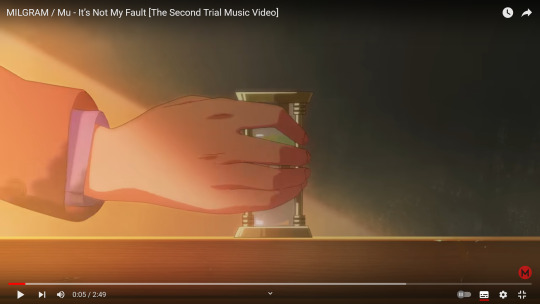
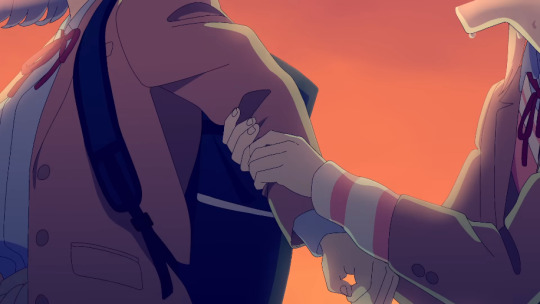
Then, after a lot of bug stuff, we're finally back in the real world, where Muu has just killed her Post-After Pain. In INMF, we don't see the surroundings as well, just the dirt track and bushes. But in AP, we see this is right next to a rushing river (Muu's undercover card also features a bridge as a landmark)

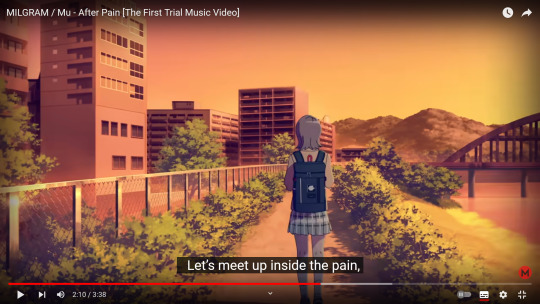
The next time we see Rei after her corpse, is a flashback to the start where she turns the hourglass over. Then it cuts just further back to before Rei stood up - as she pulls herself up off the floor She's alive and absolutely soaked after a session of intense bullying (which we saw Muu insert herself into in AP)
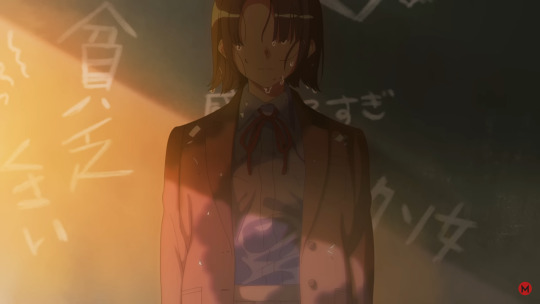
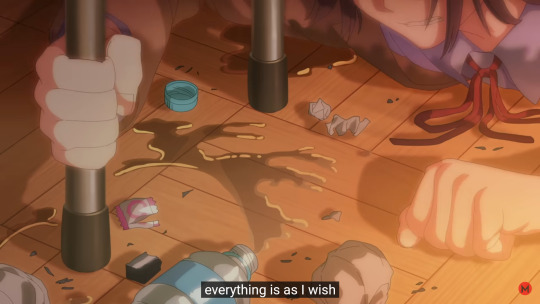
However, I want to now switch a little to talk about cinematography and a concept called the Kuleshov effect The video I linked is pretty concise but the gist is that if you put two shots next to each other, even if they were filmed separately, the brain interprets it as a continuous scene (so if you film a character looking off screen, then a picture of an apple on a table, we're going to assume they're looking at the apple)
Therefore while we understand chronologically that the sequence of events is Rei (wet and alive) -> Rei's murder on dry land ↺ Flashback to Rei still wet and alive Which I think everyone understood as a commentary on how this power struggle was a constant cycle of the hourglass being turned over
I think visually, it also implies a sequence like Rei was bullied -> Muu kills her -> Sopping wet, Rei crawls back to the classroom
But wait! That sequence suggests a missing step How did Rei get wet again?
Well, we know Muu killed her next to a river And if you were a scrawny teenage murderer with a body on your hands, would you leave it there where someone could see it while you grab a shovel and stand in broad daylight digging a hole in tough ground??? Or try lighting a fire in public??? Of course not!
It'd be much easier for Muu to, in a panic, just roll her body into the convenient river and let all the evidence wash away!
(Of course, if Muu was panicking, she might not have been very careful. Given she ended up in MILGRAM, there must've been something tying Muu to Rei's death and in T2 Muu seems to have finally remembered losing her left shoe...)
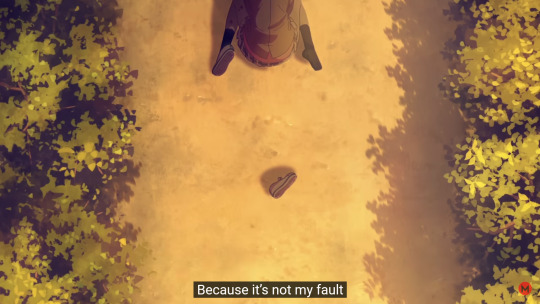
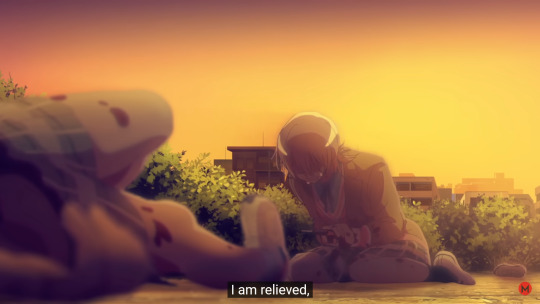
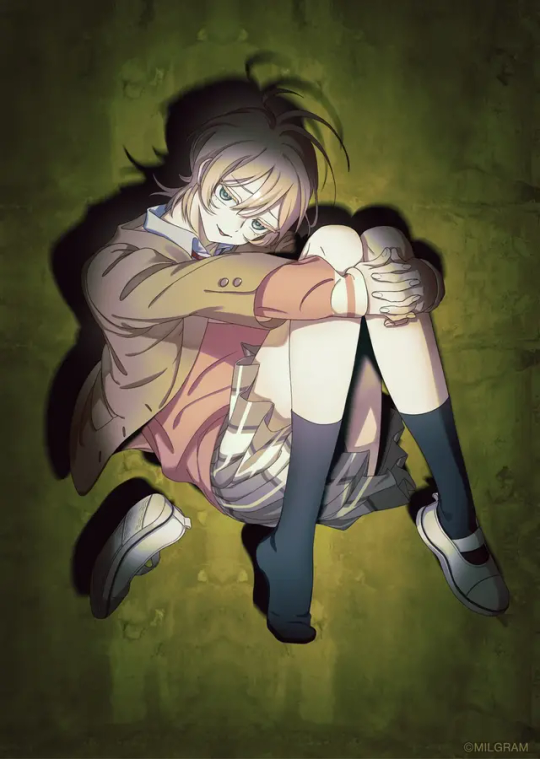
Fun fact: this is the same shoe Cinderella loses in the animated Disney film (and the best known version of that story came into English from France)
Shoe break over, back to the Endless Queen's Game
So, if we assume Rei's corpse was thrown in the river, what does it matter? Its just a pointless headcanon
But I speculate the meaning goes deeper!
So that image of Rei, soaking wet, crawling off the floor reminded me of something: J-horror ghost girls! Specifically the most famous of ghost girls Samara/Sadako Who became a vengeful spirit after being thrown in a well and now crawls out of TVs to kill people who watched her VHS tape
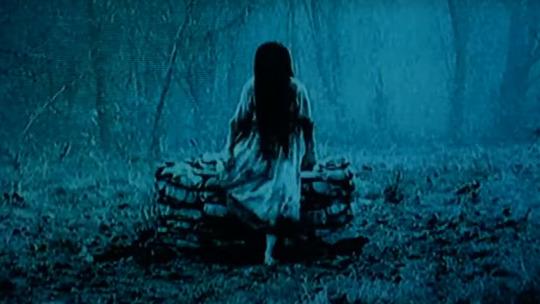
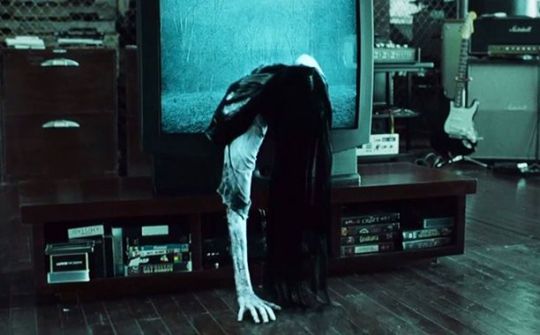
Her story too is a cyclical one (its called 'Ring' for a reason), the only way to break the curse is to copy the tape and have someone else watch it, who will then become the victim unless they can themselves copy the tape and show it to another unsuspecting patsy
The story goes back further because this movie is based on a novel, which is based on the legend of 番町皿屋敷 Banchou Sara Yashiki. There are many versions but generally a maid girl Okiku is proposed to, and when she rejects the proposal, her master breaks one of ten plates and promises to forgive her if she marries him. When she declines again, he beats her to near death then throws her into a well (sometimes it's a jealous mistress instead of a master)
Interestingly, Atrophaneura alcinous (swallowtail butterfly) larvae found in Japanese wells became known as Okikumushi お菊虫 (Okiku bugs), tying back to the whole insect thing...
It's been said a bunch now, but the name 'Rei' can be read as 霊 meaning ghost (seen in words like Yuurei 幽霊, a more common word for ghost than Rei on its own)
We know Muu is afraid of ghosts too (though I must admit she says Obake, not yuurei, but both words refer to ghosts)
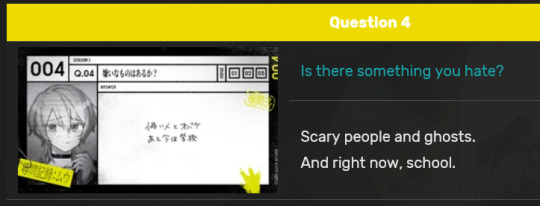

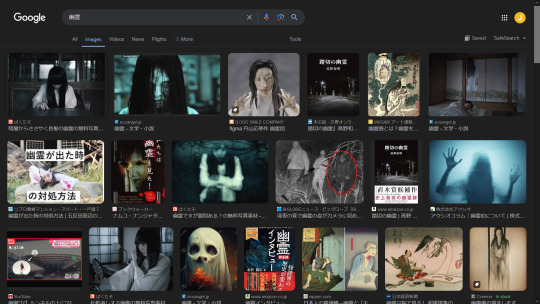
Remembers the i/井 in Sakurai/櫻井 can be read as 'well' I'm sure that has nothing to do with anything
Uh, I can't think of a conclusion because its 1 am and I had to look up a bunch of spooky images
TL;DR: I think Muu may have quickly shoved Rei's body into the river next to where the murder happened (maybe forgot her shoe at the scene of the crime) and now she's scared by the cycle continuing and Rei coming back to haunt her
#muu kusunoki#rei milgram#haruka sakurai#milgram#ミルグラム#milgram theory#I can't fit it in the post but isnt it funny how Rei and Muu's lives revolve around cycles#then Rei dies of blood loss after a sharp pain in her abdomen
285 notes
·
View notes
Text
I think my most meta milgram theory is that all the prisoners relate to social issues in Japan (this was brought up by my friend but they don't have tumblr so I'm gonna post it here)
Haruka- ableism, specifically against learning disabilities. Haruka's story is all about how he was born "wrong" and how his mother didn't want him
Yuno- the abortion debate
Fuuta- online harassment and cancel culture
Muu- bullying, and how in social structures someone always has to push someone else down to be on top (the whole hourglass metaphor)
Shidou- curroption in the organ donation system, and how brain death is viewed in Japan
Mahiru- societal expectations of women, and the pressure to marry
Kazui- okay so since his crime is vague rn, either A. Cheating or if gay kazui theory is correct B. Lgbtq issues, could also be japan and it's issues with intimacy and how his wife felt unloved but he didn't realize
Amane- Japan and its history with cults
Mikoto- ableism against the mentally ill, and the "just endure it" view of mental illness in Japan which makes alot of people reluctant to reach for mental health help. It's probably why Mikoto seems to not realize he had DID or OSDD
Kotoko- curroption in the legal system, and how crime against women and children are often ignored by the police
#milgram#milgram analysis#milgram theory#i think this is meta#yuno kashiki#shidou kirisaki#mahiru shiina#kotoko yuzuriha#haruka sakurai#kazui mukuhara#fuuta kajiyama#muu kusunoki#amane momose#mikoto kayano
1K notes
·
View notes
Text
Fuuta did not dox Killcheroy, a thread.
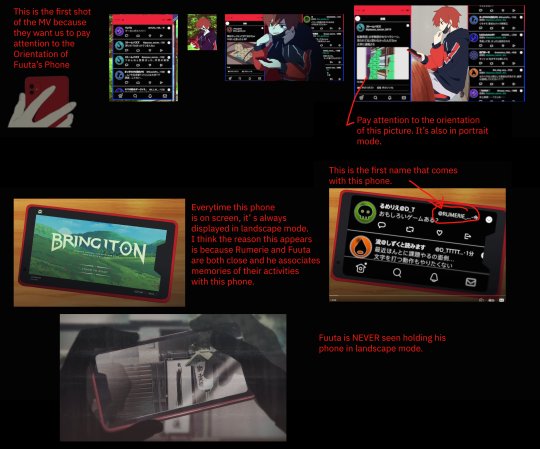

We know Fuuta is a Apple Simp especially since those types of Cameras is something associated with IPhones and the USB charger he's using. I searched high and low for this bootleg phone and I have no idea what it is. It's possible it's an Android phone or a fake one to avoid a negative association with a brand. MILGRAM puts a lot of real world details on their work as much as possible (the shoes alone is already strong...).
In Bring it On! with the MV, Fuuta has been shown again and again on his UI that his damage is minor. I feel that the doxxing would've done more damage to Killcheroy compared to the other "bosses" we've seen.
Another thing, since I know the Undercover video is being used as evidence of his doxxing. We know Muu's actual crime happened at the bridge area. Not the classroom shown in Undercover where Rei was being bullied.


It's not off to say that Muu didn't do direct bullying to Rei but is part of the group and is going down with them. Hence the confrontation. It's safe to say the same is happening with Fuuta with Rumerie.
I would love to write more about this but I've been so busy. But I keep seeing the doxxing allegation as a fact and I'm just not convinced.
59 notes
·
View notes
Text
Yuno: her struggling relationship with autonomy
(character analysis)
One aspect I have always loved about media characters is their attempt to be perceived as mature, despite their young age. Some succeed, others struggle to hide what they see as their childish side.
Yuno is no different in this context and I'm surprised that people don't talk about it enough.
Beginning with her age 18, it's truly a controversial age, if I may say. It's a confusing age, because you are technically considered an adult, but, at the same time, your mind is not fully developed to actually be one. In the end, you are still a child at heart and mind, despite the fact that you are legally an adult.
We don't know much of her home life and honestly I don't think it would do any good for me to make assumptions, since it's pointless in the long run and it would just lose credibility. However, one thing it's for sure based on Yuno's actions. She desires autonomy.
Yuno: Despite that, you arbitrarily assumed things about me and sympathized with me. Even though all I did was make a rational decision of my own free will.
I'm the one who chose, let you and you and you all in ~🎵
She highlights quite a lot with these phrases… She chose for herself, she is an adult who willingly decided to partake in compensated dating. Being called naive or innocent, two words that usually are used to describe little children, surely infuriated her… and she shows it.
It's funny now that I think about it. Fuuta also has the same problem, but his reactions are more childish, in the end, not doing him any justice. However, Yuno is no different. Of course, she does it in a more subtle manner, but she really does get worked up quite a lot when it comes to her being perceived more as a teenager than an adult. Her whole song it's literally about this idea. Yuno being infuriated that she is infantilized by the audience, making a sad backstory for her so they can dismiss the idea that there wasn't necessarily a big factor that provoked her to partake in compensated dating, but it's only her own free will.
I might add that the compensated dating itself is a way for Yuno to feel that she has more autonomy and she no longer needs to be treated as a child.
"An adult is a human or other animal that has reached full growth.[1] The biological definition of the word means an animal reaching sexual maturity and thus capable of reproduction." ~ wikipedia
Moreover, even the media promotes the fact that sexual content should strictly be watched by adults. And Yuno does end up having sex during some of these dates…
And if this idea isn't convincing enough… I think that Yuno likes to partake in compensated dating, because she knows the clients don't consider her a child. They are interested in her, in a way that makes Yuno feel satisfied with herself (at least, for a short period of time, when she is in their presence) she feels grown up and mature. She also receives money for her services, providing her with enough financial resources for Yuno to consider that she finally managed to complete one of the first steps of adulthood, to be financially stable.
Doing something that is not really socially accepted, again, can be considered as autonomy, because you do not follow the same rules that the society obligs. Yuno knows how compensated dating is perceived, but she still does it, because she thinks this action provides her "warmth".
The "warmth" that Yuno speaks about is a vague term to describe her desires. Based on her interactions, I would like to think that this term refers to genuineness and mutual understanding. Yuno, in the first VD, describes the society as being a place where "everyone eats each other". People need to point fingers at others who made a mistake, who did something that's not socially accepted to make themselves feel better.
Yuno: That’s right. You know those people who just wanna convince themselves, so they intrude in other people’s affairs even though it’s not their place—I despise them. That’s what I was saying. They only do that to make themselves feel better, don’t they? Those people don’t actually end up doing anything.
And you know what is interesting? The fact that Yuno finds more closure being in the company of some murderers. Why? Because they can also be considered some outcasts of the society that she pretty much dislikes.
Es: However, it also explains why you’ve given up. About yourself, human beings, even the whole of society, you’ve realised everything—that’s why your expression is so cold.
Teenagers usually have little power in our society. They can achieve great things, but have to go through more hardships due to the limited freedom. They need an adult to actually help them. That’s just how society is built.
Yuno's distaste for the society can explain why she has grown so fast, or, at least, thinks that she has matured enough. She was tired of the society inflicting on her rules that she, as a simple teenager, had to oblige. So, going into Milgram, starting to hear people crafting a sob backstory for Yuno, treating her like a child, despite the fact she has already done a few steps in order to sustain herself financially and emotionally as a young adult, it's truly insulting.
Es: This is just popular belief, but the law is also something the people have decided. There’s nothing, which can satisfy every single human being, now is there?
Yuno: That’s right.
However, even after all these, that doesn't mean she doesn't actually struggle with this new found autonomy that she craves.
I actually think that this autonomy is the cause of most of her suffering.
As I stated before, compensated dating is something that she decided to partake in, in order to prove her independence. She thinks that what she has chosen for herself is healing, helping her. But, if it's that the case, then why do we have these scenes?
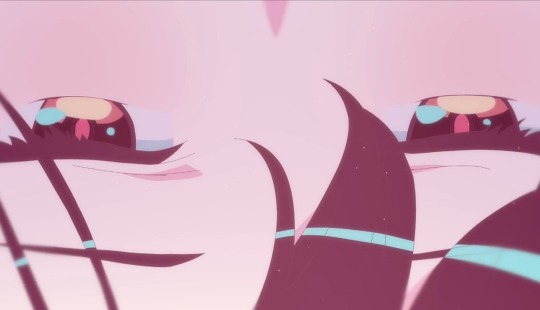

It's difficult to admit that one of your decisions was actually… Quite wrong. Especially, when it's one of your first one's as an official adult, in the very first stage of your life when you finally have enough independence.
“Cognitive dissonance is what we feel when the self-concept — I’m smart, I’m kind, I’m convinced this belief is true — is threatened by evidence that we did something that wasn’t smart, that we did something that hurt another person, that the belief isn’t true,” said Carol Tavris, a co-author of the book “Mistakes Were Made (But Not by Me).”
She added that cognitive dissonance threatened our sense of self.
To reduce dissonance, we have to modify the self-concept or accept the evidence,” Ms. Tavris said. “Guess which route people prefer?”
So which one does Yuno prefer? To convince herself that what she is doing makes her happy.
Yuno: Despite that, you arbitrarily assumed things about me and sympathized with me. Even though all I did was make a rational decision of my own free will.
Yuno: I’m not pitiable. My family gets along super well. And I’m not particularly struggling for money. I decided, of my own free will, to do it because I felt that it was necessary for me.
Sometimes, considering how many times she mentions it, for me it feels like Yuno tries to convince herself that what she is doing is good for her.
But you know what is funny to me?
She is good at making herself enjoyable for others as well as giving somewhat good advice:
Mahiru: My birthday…… the day I was born……But was there really any reason for me being born? Lately I’ve started to wonder that. Do you ever think about stuff like that, Yuno-chan?
Yuno: Eh? Not really. I mean, Mahiru-san, you’re really the romantic type, right? Not that I have anything against that. But isn’t it a bit much to think that everything in life has a meaning? If it makes you happy to think like that then go ahead, but if it doesn’t, then isn’t that in itself meaningless?
Mahiru: : ……you might be right. I’ve always just lived my life like this, so I don’t really know.
Yuno: We’ve all just gone through a bunch of things in life that happened to lead us here. It’s nothing more than a coincidence. Definitely not fate or anything. Probably. Even if there isn’t a meaning, you can still be happy that it’s your birthday. That sort of thing’s all you need in life really. So happy birthday, Mahiru-san.
Mahiru: ……no, I’m fine. As long as I don’t move too much I don’t even feel any pain. Sorry for making you worry.
Yuno: Oh, really? That’s good then. Mahiru-san, if there’s anything you want then just ask. It’s not like it’s a huge burden, I can just ask for it along with my own stuff.
Mahiru: Ok…… I’m fine for now. Sorry, for making you worry. Ah, Yuno-chan…… Today’s your birthday, right? Happy birthday.
Yuno: …Haha, thanks. Thank you, but y’know. Is it really ok for you to be saying that to me when you’re in that situation?... you really aren’t suited for Milgram, huh, Mahiru-san.
Amane: What is it… Kashiki Yuno. Don’t sit so close to me. Go away.
Yuno: Sorry for barging in when you’re getting into your worldview thing. But Mahiru-san’s finally managed to get to sleep. Humour me with some small talk while I take a break. By the way, Amane. Have you ever wished you were never born? I’ve thankfully lived a pretty fun life so far, so haven’t really. But you seem to be struggling with something. So I kinda wondered if you thought like that.
Amane: ……I don’t think that. Being born into this world is the first miracle any person experiences, and is something to celebrate. Even if after birth I was put through trial after trial, the value of that will never disappear.
Yuno: Hmm. Ok…happy birthday, then. It’s good that you were brought into the world, I guess.
But Yuno has a big, and I mean a BIG tendency to self-destruct, not intentionally.
Wanting to be independent comes with its own downfalls. At the beginning of the trial, Jackalope states that Yuno has distanced herself from social interactions. So much so, that we have never seen her actually confiding to someone else, in any of the portal timeline translations. She might have her reasons, either minimizing her problems, and using her energy to help the ones she deems to have worse than her, or, this is simply her nature to bottle up her own sadness. This again might also be the cause of her wanting autonomy and proving to herself and others that she is mature enough to manage her emotions.
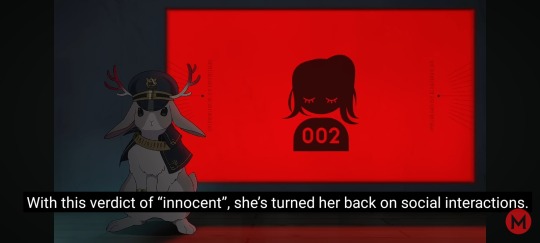
Not confiding in someone else for a long time can cause depression. Something that Yuno might be struggling with during trial 3 or she is already struggling with it a bit.
Furthermore, it's interesting that Yuno admits disliking behaviors that she deems childish. For example, she doesn't like the way Haruka and Muu behave, because they are ignorant of the problems in prison and have a really childish way of thinking. Amane's hate towards Shidou, might be often wrongly interpreted as a simple child's tantrum. Kotoko's actions, responding with violence to violence, it's again, an aspect often deemed as childish and immature.
Yuno: Really? If you ask me, Kotoko is someone I would never want to make my friend, though. She’s the type who picks a conclusion from the very beginning and won’t actually talk with you.
Yuno: Well, I guess it’s arbitrary who one gets along with. But Mahiru-san in particular is something. I think both her body and mind are at their limits. Also, Mikoto-san was also attacked but apparently it ended up in something of a draw. That guy was strong, huh—how unexpected. Also Haruka and Muu-chan have become kind of bothersome. And additionally, Amane-chan and Shidou-san too, huh.
Lastly, her second MV also shows her desire of autonomy in Milgram, not only through lyrics, but through visuals too.
Beginning with her door, it looks a lot like a medieval castle door.


Her room, the way it is designed, especially the bed and the chair, also resemble a princess' room.



However:
Despite the important role that princesses played in courtly life, they had limited personal freedom. They were often kept under close guard and were rarely allowed to leave the palace or castle where they lived. This was done to protect them from danger and to prevent them from engaging in political activities that might undermine the authority of the king or prince.
Medieval princesses had little to no autonomy most of the time. Their life was dictated from the start, having the only purpose to be betrothed and give birth to children.
That’s why the design choice is intentional. Yuno feels like a princess trapped in her pretty room (the MV is quite claustrophobic, the only outside elements being a few memories), exposed to the world (the many windows imply this), the voices that keep demonizing her.

That’s why the scene where she starts breaking things in her room is so important. It serves as a sign of rebellion, to show that she is not the perfect, helpless princess that people like to portray her as. She is an adult who makes bad or good decisions, who thinks for herself. She is proud of her autonomy and is tired of constantly proving to others that she is not capable of taking care of herself.

#My birthday is on Tuesday so I've decided to write a character analysis of my favorite milgram character!#I actually wanted to post it tomorrow#but I'm sure I would have just ended up being unsatisfied with what I had written!! #I hope you enjoy this as much as I enjoyed making it!#Yuno is very fun to analyse as a character#milgram#thoughts#milgram theory#character analysis#milgram yuno#yuno kashiki#milgram mahiru
142 notes
·
View notes
Text
Shidou Kirisaki killed for his son, not his wife
After a lot of thinking, I think I've got a solid theory for how Shidou's crime went. Stick with me here
His wife and 2 kids get into a car crash, and only his oldest child survives. He needs organ transplants, but due to the complicated perception of brain death in Japan, there's not enough organ donors.
Shidou starts trying to convince families of brain dead patients to sign them up as organ donors, but doesn't get the organs he needs for his son because he's not in control of what goes where obviously.
He gets more desperate as time goes on and his child's state worsens, and just kills braindead patients himself, making it seem like an accident. Again he's not in control of where the organs go, so he has to kill many people so that the organs can go to his surviving family.
His son dies during the organ transplant, or shortly after.
Shidou turns himself in because he has nothing to live for anymore.
Evidence & other details under the cut v
The car crash
In the intro of Triage, Shidou is walking home with groceries. By itself it's not weird or anything, but it could imply that his wife had the car to drive the kids to or from school at that moment.
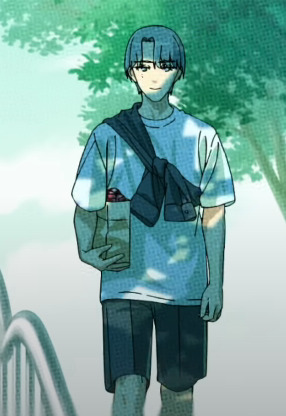
In the scene of Throw Down where Shidou wakes up (alone, in a double bed), it zooms on broken glass on the floor. Glass in cars are made to break into pieces when they suffer shock.
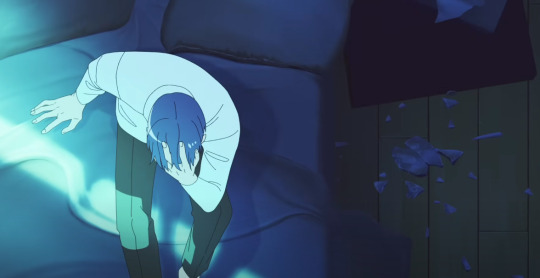

In his T2 interrogation, Shidou is asked that question.

His wife and youngest kid die in the crash, his oldest kid is the only one that survives
In Triage, his youngest child is always clinging to their mother, implying a certain connection between them. (this is going somewhere I swear)
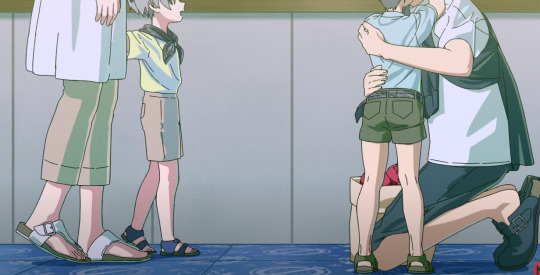
The theme of receipts being patient files is present in both Throw Down and Triage; so when this scene in Triage happens, it implies that he's giving those lives to his son. He does not do the same for his wife, or his youngest kid.
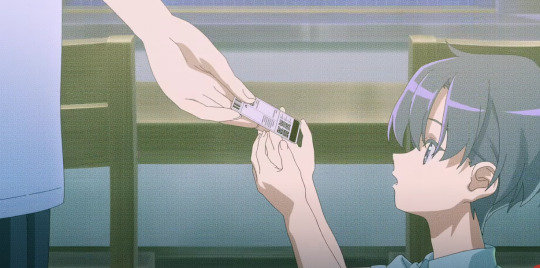
In the part where he puts his hand over his face in Triage, you can see that. Again with the 2 groups.

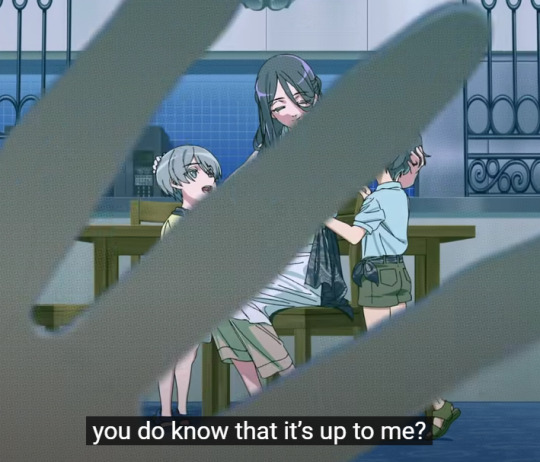
In Throw Down, 2 wilted flowers are under a glass case, while one wilted flower isn't. That could symbolize that 2 of them are enclosed in a coffin, and the last one isn't, even though he's already wilted.
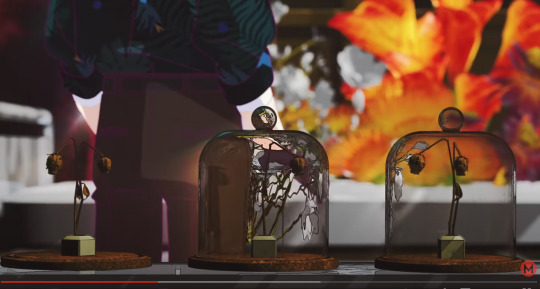
The receipt/patient file that Shidou rips up at the end of Throw Down: it's hard to see what it says exactly (what organ IS that), but you can see that the XY chromosomes are ticked off. So unless his wife is trans (which would be great), the last file to expire, or be destroyed, or the life to die, is a boy's. That's why I keep referring to his oldest child as a boy (unless that child is trans which would be great again, but I doubt that milgram would do that). The name there says something like Rei/Kei/Kai Kirisaki. It would be confusing if both Shidou's son and Mu's victim are named Rei, but that might be the case.
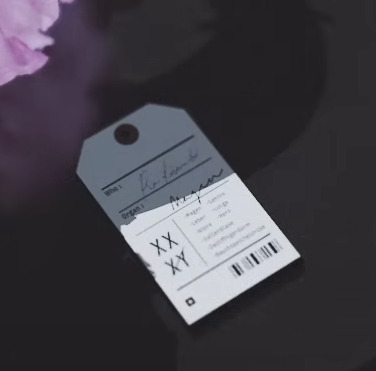
Shidou tries to convince families to sign their braindead relatives as organ donors
Aesculapius:

Shidou stops asking and just takes the organs (or kills the braindead patients) himself, passing it off as accidents
Throw Down: You can see him reassuring a grieving family, and "sniffing out lies"

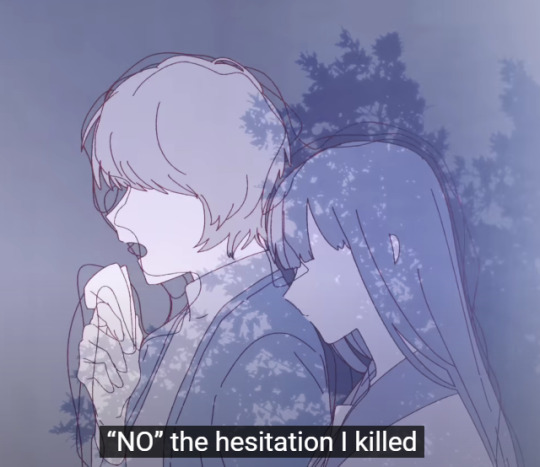

Aesculapius:

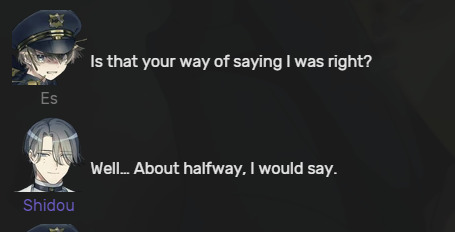
I think it would be weird if his "murder" was just convincing families to sign their relatives up as organ donors (even though that does count as medical malpractice)
His son dies during the organ transplant, or shortly after
Throw Down: His human-shaped flower abomination starts moving again, but after stepping out of the hospital bed, it crumbles into pieces, and Shidou is horrified. Flowers represent the lives he's cutting to add to it.
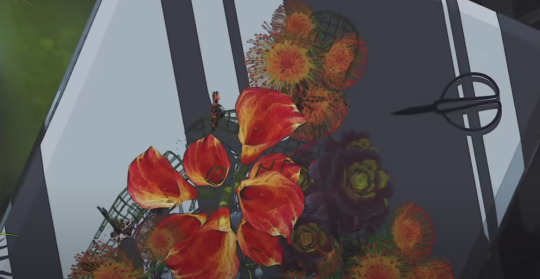

Shidou turns himself in
I have no evidence for that one, but what else would he even do. In the start of T1, he's asking for the death sentence.
Other Fun Facts:
Shidou used to cook pancakes for his kids. That's why he's so insistant on Amane trying them in minigram. (There are two plates of them on the floor.)

His children liked to draw. probably why he's started drawing as a hobby in milgram.
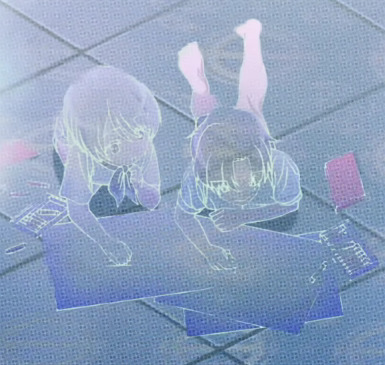
The intro of Triage where he's walking home with groceries is (according to me) a memory of the day he got the news of the car crash. You can see the groceries through the MV, discarded on the floor or rotting. They're pomegranates, whose insides look like human organs - and he gives the receipts for them to his son. At first it's just groceries, but then they're human lives.
The phone call translates to "Hi this is Kirisaki, I'm busy right now, please call later" or something like that, implying he was busy when someone called to inform him of the deaths.
#milgram#shidou kirisaki#milgram theory#talking#i got some of that from a tumblr post#but ive lost the link#most of this is the fruit of my thinking though
212 notes
·
View notes
Text
AAAAAAAAAAAA
Okay look, I think I'm going insane. We learn here in Double that Orekoto seems to be right handed, right?

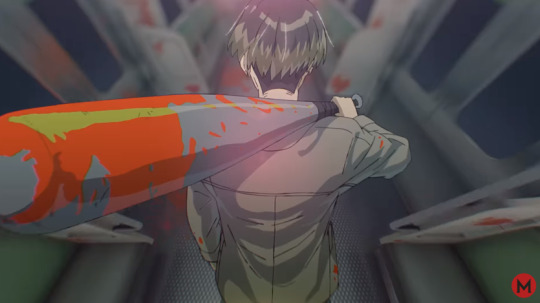

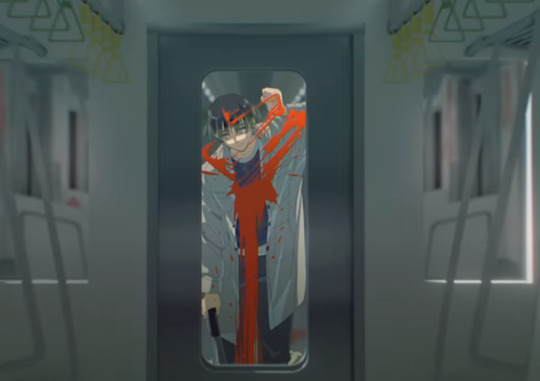

Right? He always holds the bat with his right. And when he goes to swing, he swings with his left facing the "pitcher", which is how you swing if you're right handed.
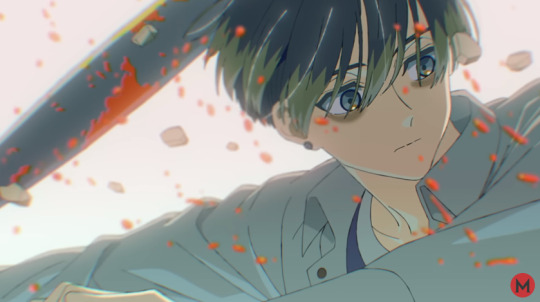
Except.
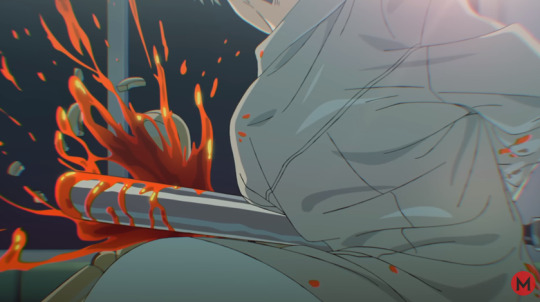
There, his right is to the pitcher. That's a left-handed swing. You can even tell it doesn't make sense that that's the same swing just looking at the two images.
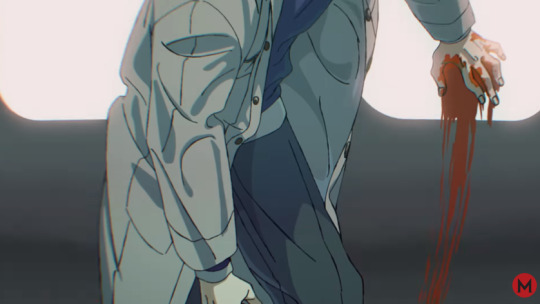
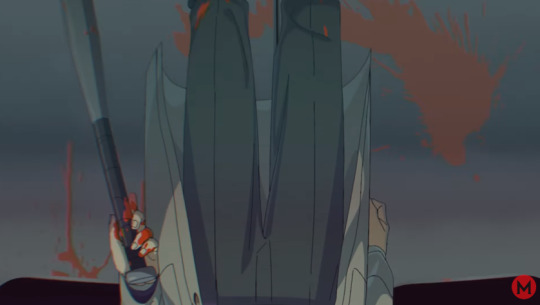
The bat is on the left. Only the left hand is bloody. And even the backside of the hand is bloody, so it's not like we're not seeing the blood on the right, there just isn't blood there. But notice the first alter isn't holding the bat.
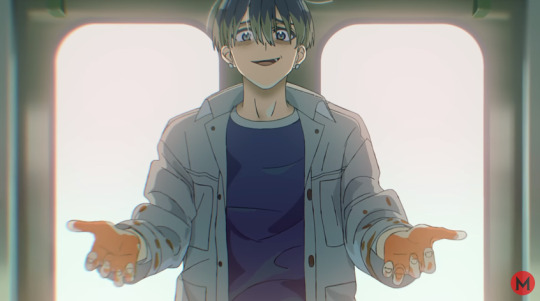
Ends with blood on both hands.
Guys, I think we've gotten something wrong. There may not be just one murderer. Two alters have killed, I think.
#ill come back to this after eating#but im going insane#milgram#mikoto kayano#milgram theory#double mv#cw murder
329 notes
·
View notes
Text

The website no longer says "Now, sing your sins" when loading in but instead this, which as far as I can tell reads something along the lines of "These are our sins."
“Bokura” implies Es says it, and since they also said “sing your sins” it makes sense. Watch them be a backup vocalist on every T3 song since they feel responsible for what happened now.
#I might be reading that last kanji wrong but I'm 90% sure it's a stylized 罪#if I have read it wrong please tell me!#milgram#milgram project#milgram trial 3#es milgram#milgram theory#<-technically
124 notes
·
View notes
Text
Chessgram Theory: Who is Kotoko Breaking?
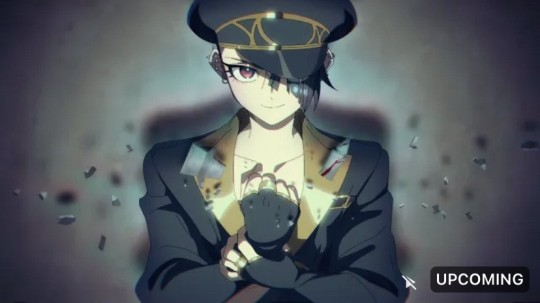
While the object Kotoko is breaking in Deep Cover’s thumbnail is still certainly up for debate, many people (including myself) are of the belief that she’s snapped a white bishop from the game of chess. Given where Kotoko’s mental state is right now and what’s implied by the lyrics of Deep Cover, I think it’s likely that this MV’s theme will depict all of the prisoners as different chess pieces. Therefore, it’s worth asking: who is that? And, in a larger sense, which prisoners could be represented by which chess pieces?
Kotoko pretty clearly sees her situation as her and Es against the rest of the prison. So, I think that the characters would be divided as Kotoko and Es on one team, and everyone from 01-09 on the other. Kotoko is wearing black and appears to be breaking a white piece, so it’s pretty safe to assume that she and Es would be represented by the black pieces. It’s an interesting choice, given that, even to a non-Western audience, black can be considered a color of evil, and white a color of purity and truth. However, if the Es/Kotoko team is “mystery and anger” and the 01-09 team is “cold demeanors and death,” it fits well enough.
And that’s ignoring the most important part: in chess, the white team always moves first. This would fit with Kotoko’s vigilante worldview that everything she does is just a retaliation against others’ wrongdoing. The other characters attack first by sinning, and Kotoko is only picking them off before they can do any real damage to Team Warden.
Anyways, as for the pieces themselves, different websites seem to have slightly different opinions on what each piece can represent, with some obvious throughlines. I’ll be pulling quotes from these three articles, color coded according to which one is being used, which you can read more of if you wish. I’m also not a chess expert, so if I’m missing anything or got something wrong, I encourage you to add any of your own thoughts!
We’ll start with the Black Team, because there are fewer characters and I think it’s pretty obvious who’s who.
Kotoko Yuzuriha
Kotoko herself will probably be the black Queen. As anyone who’s played chess should know, your Queen is the most powerful piece in your arsenal because it can move on straights or diagonals for any distance.
The queen is our impulse to fight and possibly our id. It can argue based on beliefs. It can let loose and fight like a rook. It has no reason to hold back as a knight does and will often attack to the other side of the board just because it wants to.
This hyper-violent description of the Queen reminds me a lot of Kotoko. She attacks the other prisoners because, according to her beliefs, they’re criminals who deserve to be punished. Not to mention, the “id” is actually the same thing as the “es” in psychology. After we voted her innocent in the first trial, Kotoko became our teammate. She thinks that she’s the same as Es, so seeing herself as the “id” would fit perfectly with that self-assessment. Speaking of Es…
Es (and Jackalope?)
Es is most likely going to be the black King.
The king is not as powerful as the queen, but he is considered the most important piece that needs the most protection.
Even if Kotoko has more power than Es inside the prison, Es is still the one ultimately calling the shots. They’re the important piece who actually casts the votes that Kotoko can use to exact justice. The way that Es falls asleep between trials (or, at least, they did the first time) also reminds me of how the king can only move one space per turn, and often remains in the same square until closer to the end of the game.
The meaning of the Queen in the game of chess is she is plainly the closest support to the King and is often the second biggest (tallest) piece on the board, signifying her power and importance.
Es and Kotoko being the King and Queen together also opens them up to being assessed as a pair. They start the game next to each other, far across the board from the white pieces. If Es is the tallest, most notable piece in the prison, Kotoko isn’t far behind, acting as the King’s loyal fang.
I don’t know if any of the other pieces on the black team would have any sort of particular association. Maybe Jackalope could be the pawn that starts in front of the King (I think that’s the E pawn), so that he could hop out of the way on black’s first move to allow Kotoko to escape on a diagonal?
If I’m right about this theming, I also believe it’s possible that the black team would start only with the King and Queen. This would 1) make Kotoko and Es appear as rootable underdogs by having fewer pieces, 2) show how Kotoko is doing all of the work to defend justice, and 3) give Kotoko a lot of space to move around in from the start.
Now that we’re done with the black team, it’s time for the 01-09 White Team! Given that this side has many more main characters, there are several more possibilities to discuss here. I’ve settled on an answer for each of the prisoners, but there’s certainly room to be flexible with any of them.
Haruka Sakurai
Starting with Haruka… sorry, buddy, but I think you’re a Pawn.
Look, there are only eight pieces (not pawns) for each team on the board. If there are nine prisoners on the white team, at least one of them has to be a Pawn. And, especially through Kotoko’s account of the first Trial, Haruka wasn’t doing a whole lot. He didn’t get voted guilty, so she didn’t attack him, and he didn’t try to save any of the attacked prisoners, either. All he really did was get a new fit and align himself with Mu, someone who barely avoided being voted guilty in the first place.
There is a debate about whether the pawns are the peasants who live outside of the castle walls or are the soldiers protecting the royal court behind them.
Specifically, though, I think that Haruka would be the pawn that stands in front of Mu. Depending on which piece Mu is, it doesn’t have to work like this, but if you say that Pawn Haruka’s placement is basically a “if you want to attack her, you’ll have to get through me first,” that’s quite reminiscent of the threat he presented in his second audio drama.
Haruka also makes sense as a Pawn because he has a lot of potential. For anyone who doesn’t know, in chess, if a Pawn manages to make it to the other side of the board, they can transform into any other piece. Haruka’s quiet demeanor might let him slip under the radar, but if Kotoko takes her eye off of him for too long, he could wind up becoming a threat to the King (Es).
Haruka (VD2): “If you don’t forgive Mu-san, I’m going to kill you.”
In the audio drama, Es counters this plan by pointing out that, as a prisoner, Haruka cannot attack them. However, the sentiment is still there. Even if a Pawn doesn’t really stand a chance of attacking the King when Queen Kotoko is on the loose, there’s always the possibility that he could get too close and throw a wrench into Kotoko’s plans.
Yuno Kashiki
As for Yuno… well, we all know that she’s a Queen in general, but in chess, I don’t think that argument really holds up. Yuno really just isn’t… relevant? enough? to the conflicts of the prison as a whole (at least where Kotoko is involved) to be represented by such an important piece. But, if Yuno isn’t the Queen, what would she be…?
Personally, I think she would be a Rook.
The rook is brute force. It is a disregard to beliefs.
Simply put, Yuno is a Rook because she’s a pretty straightforward person. That’s not to say that she doesn’t lie, of course– her whole t1 attitude seems to have been a bit of an act, and that one section in the middle of Tear Drop makes it pretty obvious that Yuno conceals her true feelings on order to better please her customers sometimes– but that, in the end, Yuno always does what she wants. If she wants to barge forward or cut across the entire board sideways, she’ll do it. She often keeps to herself, just like how enemy pieces wouldn’t want to get directly in front of the Rook for fear of being curb stomped.
Back to her t1 attitude, though…
The rook is the castle, the walls, the protectorate of the city, and in being so, is the only piece not representative of a living thing.
While most sources attribute the Rook’s walls to protecting the other important pieces, Yuno’s walls protect herself. Yuno’s Castle keeps her true self locked behind cold and stony walls, giving her freedom from making any attachments.
Futa Kajiyama
Futa is a Knight because… he’s, uh, literally a knight.

The knight pieces are the protective knights in the castle. The pieces are shaped like a horse because it is symbolic of what knights rode during battle.
It doesn’t always have to be that deep. (/j)
Actually, though, there are other reasons to call Futa the Knight– possibly some of the same reasons why the Milgram creative team decided to make one of his MVs themed after fantasy RPGs in the first place.
The knight represents the pure inner-warrior. If a knight starts out passive, it will always end up aggressive and vice versa. It can't move very far, but it never moves in a straight line, always preferring to be tactical and thoughtful.
Futa definitely seems to cycle between aggressive and passive. He passively lived his life as a regular guy until he unleashed his aggression and became a cyberbully. That aggression fueled him until he learned of his victim’s death, at which point he shut down and seemed to become more passive and introspective again. Arriving in Milgram triggered his aggressive tendencies, but getting voted guilty and losing an eye for it triggered his passive terror. At the time of his second audio drama, it seems like he’s returned to aggressively questioning Es again, and it remains to be seen whether he keeps that attitude into t3 or if something happens that once again makes him lose his footing (or die).
Mu Kusunoki
Much like Yuno, Mu also has an argument for being called the Queen– more so than Yuno, considering her strong Queen Bee coding in It’s Not My Fault and the titles of both of her audio dramas– but also falls short in the “being opposed to Kotoko” department. Although Haruka certainly looks to her for leadership, I can’t imagine Kotoko actually considering Mu a serious enough threat to put Mu on the same level as herself.
So again, like Yuno, I think Mu might be the other Rook. Mu also displayed a very “whatever I say goes” attitude in INMF, so she can share the same rhetoric behind Yuno being represented by that piece. The logic behind the castle aspect is slightly different, though.
Every country or medieval estate would have its royalty who were protected within the walled city or castle.
Mu is a rich, half-European girl whose dad sells real estate. Of course she would be represented by the Castle! Mu’s tactics involve consolidating her power in order to lead from a place above it all, exactly like how a castle looks over the rest of the village. Additionally, I can’t find the source of whoever pointed it out first, but I’ve seen it mentioned that the dress Mu wears in her birthday art is a reference to the one that Belle wears in Disney’s interpretation of Beauty and the Beast. It’s a fairytale with a princess (and perhaps someday, a queen), yes, but it’s specifically one where the heroine is trapped within a castle. Making Mu into a Rook would be a great way to keep up her royal theming, while leaving the Queen for a character a bit more powerful and relevant to Kotoko.
(Going back to Haruka for a moment, this would make him specifically the A or H pawn.)
Shidou Kirisaki
I really thought that Shidou might have more competition for the role of King, but the more I thought about it, the more I realized that nobody fit the role quite as well as he did.
Shidou is the perfect balance of a piece who’s very problematic for Kotoko’s win condition, while also not being much of an active threat himself. There are very low odds that Shidou would ever actually try to harm Kotoko directly or get in her way to divert an attack. However, as long as he’s alive, Kotoko can’t win, because Shidou can keep attempting to heal all of the pieces Kotoko tries to eliminate. That’s not something that the King piece can actually do in a chess game, but hopefully you get my point.
Additionally, Triage let us know that Shidou is a family man. While the white Queen will obviously not be representative of Shidou’s deceased wife, and not every other prisoner would enjoy living under his reign (cough cough Amane), the optics of him being the “head of the family” are obviously there. It’s a pretty bad look if the white King starts the game by pleading with the black King to give him the death penalty, but… Well, at least Shidou changed his mind.
Mahiru Shiina
Not to answer the theory’s main question so early into the post, but… I think Mahiru is a white Bishop. Specifically, the one that Kotoko could be snapping in half in the thumbnail.
As far as I can remember, barring Undercover, Milgram’s MVs have only shown us things that have happened in the past. There are some things that could kind of hint at the future (like Shidou’s “So hey, prolong my life / I’m indispensable” in Triage) or depict prisoner’s fears of the future (like Futa potentially being afraid that Es could declare him guilty again at the end of Backdraft). But, I think that every instance of something like that happening could be explained as something that the character did or thought about in the past as well. That might be wrong, as I don’t want to take the time to write out how everything that appears like it could be in the future is actually in the past, but it sounds right to my memory.
My point being, while the snapped bishop could be indicative of Kotoko’s plans to crush someone in the future, if the chess pieces do represent characters, it makes far more sense if her smashing the white bishop is something that already happened in the past. Thus, it would probably be one of the three characters that Kotoko attacked in the past: Futa, Mahiru, or Mikoto.
Of the three options, I think Mahiru fits the role of bishop best.
The bishop is your belief structure. This is why a bishop that starts on white, will always be on white and vice versa for the black bishop.
While not a particularly religious person, Mahiru is someone who lives and dies based on her beliefs about the value of love. No matter what happens to her, she always keeps her same perspective, believing that love is the entirety of who she is and the only thing that’s worth living for. It’s how firmly she clung to those beliefs that sent her to Milgram, and her lack of awareness regarding her actions that got her voted guilty. AKA, Mahiru’s Bishop-like beliefs are exactly what sent her to be crushed in Kotoko’s palm.
To the extent that the blood in the thumbnail is the Bishop’s and not Kotoko’s, Mahiru was also the most grievously injured of the prisoners in between trials. I saw people joking that the thing Kotoko was crushing was “Mahiru’s bones,” and, like… maybe you’re not entirely wrong?
I hope that you continue reading the post to hear my thoughts on the last three prisoners. But, if you are tapping out here… uhhhh, 0610 enjoyers, go crazy with this one.
Kazui Mukuhara
When I started theorizing for this post, I really thought that I was going to make Kazui the Queen to Shidou’s King. The two of them are pretty close, so the idea of Kazui being Shidou’s guardian makes total sense. And, most importantly, Kazui was the one to actually intercept and divert Kotoko’s attack on Futa. He’s been established as the most muscular prisoner in Milgram, on par with someone like Kotoko, which is perfect for him being the Queen!
Wellllll… I changed my mind and decided to make Kazui a Knight anyway.
There are a lot of good arguments for Kazui being a knight too, okay? After Cat, it’s pretty clear that Kazui was once a police officer. Thus, being a member of the castle guard would be a good match for his choice of career. They’re also probably the most traditionally “manly” piece, representative of an armed man on a horse, and Kazui tries very hard to be manly.
Knights can also hop over other pieces, much like how Kazui jumped into the fight between Kotoko and Futa. In fact…
Never underestimate [the Knight] for its limited range. It’s known as the "Queen Killer" for a reason!
Knights are often a good piece to use to attack Queens because of their unique L-shaped movement pattern. Unlike every other piece, they can attack the Queen from a position that can’t be immediately reversed upon them. Thus, Kazui’s ability to beat Kotoko could be an indicator of this “Queen Killer” quality, instead of the innate power of being a Queen himself. (This logic applies to Futa as well: he can attack Kotoko from the unique angle of appealing to Es’ morals and own sense of justice. Kotoko can’t do the same because, unlike Futa, she has yet to outwardly acknowledge that her murder could have been anything less than righteous.)
Also… the Knight is the only piece that doesn’t move in a straight line. Get it? The Knight doesn’t move straight? And that represents Kazui? Because Kazui is–
Amane Momose
Amane is the other Bishop because… religion.
The bishop stands close to the king and queen because it represents the church which many royal courts held near and dear to their hearts.
The Bishop represents the church, an important and very powerful entity throughout history and even today if you think about it.
Again, not everything has to be a reach. (/j)
So… yeah, Amane’s beliefs– specifically religious beliefs, this time– are also a huge part of her life. Even if she’s changed what the cult’s doctrine means to her, she still confesses that she carried out her murders for the sake of what her religion considers right and wrong.
This is also considered the third most powerful piece on the chessboard because back in the day religion could influence many people, even without the help of the royal family.
Not so much for Mahiru, but this sentiment also fits Amane pretty well! Between the threats of potential conversions and potential assassinations, Amane was definitely one of the prisoners to watch heading into t2. From what I’ve heard, the main reason why her vote was so down to the wire was mostly because people were afraid of the power that Amane held.
Interestingly, this would put another prisoner who was voted guilty in contention for the piece that Kotoko is crushing. However, I still think it’s more likely that that piece would be Mahiru, because Kotoko didn’t physically attack Amane. If it were Amane, it would more likely be that her beliefs were crushed as opposed to her bones, but… I don’t really think that really happened, either. Amane would almost certainly be a bishop, though, so there’s certainly a possibility that that broken piece could be her.
Mikoto/John Kayano
With only one prisoner left to go, you may have already come to the conclusion that Mikoto is the white Queen. And… yeah, I can’t really deny that at this point. Like I said, I wanted to make Kazui the Queen, but I couldn’t otherwise figure out what Mikoto would be.
Because, there’s one main thing that makes me think that Mikoto has to be the Queen… John’s lack of restraints.
She is allowed to move in any direction and in as many squares as she wants.
Due to the whole situation with John not technically being a prisoner, when John is the alter in charge, John cannot be restrained, even when voted guilty. That makes him very powerful; no matter what he does, we can’t use a guilty vote to try to stop him, much like many people hoped to do with Haruka when voting him guilty in t2. The Queen can visit any square, no matter whether it’s black or white, upright or reversed, Mikoto or John. Choosing any other piece that was constrained to a much more limited set of movement rules just felt off for him.
Next, while Kazui was able to defeat Kotoko and save Futa, the fight between John and Kotoko was a draw. That means that they are also evenly matched– perfect for both being the same kind of piece. Mikoto isn’t as close to Shidou as Kazui is (anymore, I think?), but they were at least smoking club buddies, so calling Mikoto the Queen to Shidou’s King isn’t the most ridiculous proposition.
Finally, making Mikoto the Queen, a very feminine piece, is super interesting in the context of people discussing how Mikoto is often associated with stereotypically feminine roles and the girl prisoners (oboetemasuka | candckirby | purgemarchlockdown). I don’t have a whole lot else to say on this matter considering these weren’t points of Mikoto’s characterization I originally noticed myself, but I encourage you to read these posts to get a taste of what I’m talking about. I’m sure there were other posts discussing it too, but… it’s so hard to find things on Tumblr ;-;
Conclusion
Finally, we’ve been through every prisoner! Here’s a summary of what I decided on (left or right side doesn’t matter):

The funny thing about this theory is that it could be fully disproven wrong in, like, a week, if either 1) that wasn’t a chess piece at all, or 2) the chess pieces obviously represent something else. For instance, the chess board could fully relate to, you know, Kotoko’s actual murder and not what she got up to in between trials. We are supposed to get more actual evidence regarding that too, aren’t we…?
Still, if it turns out that the chess board does represent Milgram, I will get the full satisfaction of having called it ahead of time, even if my assignments aren’t 100% correct. No matter what, I had fun thinking about it, which is (in my opinion) the highlight of theorizing! If you have anything else to add, I encourage you to communicate your thoughts in comments, tags, or reblogs. If you don’t, then I simply thank you for reading this far!
Deep Cover… soon.
#milgram#milgram theory#deep cover#kotoko yuzuriha#es milgram#jackalope milgram#haruka sakurai#yuno kashiki#fuuta kajiyama#mu kusunoki#shidou kirisaki#mahiru shiina#kazui mukuhara#amane momose#mikoto kayano#john kayano#i hope nobody else wrote about this yet i didn't see anyone do it#i am not the most knowledgeable about milgram so hopefully i didn't overlook anything big#but i hope i'm right. that would be exciting!#would be kinda funny if it's not even a bishop though#my theories
213 notes
·
View notes
Text
on mahiru's relationship

I wanted to write something up really quickly as to my opinions on Mahiru's relationship and what the dynamic there was like. I've seen a lot of people identify her behavior as "toxic", and some people even state that the relationship must have been toxic on both sides (often leaning heavily on the cake in I Love You as a metaphor), but I don't often see this stuff dived into deeper than either identifying Mahiru's bad behaviors or just saying they're both "toxic" without really talking about... why. Or what that means. Or how her boyfriend is toxic. I don't even really like the word toxic in this case because I feel like it's just being used without really delving into why or how in any real way, it's net zero information other than telling us it's bad. I want to step aside from the perpetrator-victim dynamic that MILGRAM puts things in the framework of. My key thesis is this: Their relationship is hurting them both in different ways. Both of their desires/needs are incompatible and going unmet. Neither of them are bad or wrong for wanting what they want, although Mahiru does display several behaviors that, while understandable, are ultimately harmful and unhealthy.
Let's look at the cake metaphor again. I see a lot of people say that the cake represents toxicity/bad behavior/unhealthiness in the relationship and that it's clearly both-sided because they're feeding it to each other. I don't... think this is a wrong interpretation, per se, but I think it misses an aspect that's kind of key to me?
In my opinion, the cake also majorly represents attention/love. Notice how the pieces Mahiru's boyfriend is feeding her are smaller than what she's feeding him?


When Mahiru is being fed the cake we never see it portrayed as anything but cake. She looks happy. She thrives off this attention. When her boyfriend is being fed the (larger piece of) cake... he sees it as a dead rat. We only see the rat transition when it's Mahiru feeding the cake, because he's the only one who is being smothered by the love/affection. She feeds her boyfriend more cake because that's what she thinks will make him happy- because love and attention are the things that make her happy. Because that's what she wants him to do. To put it another way: she's smothering him while he's not giving her enough.

Mahiru is clingy and overly-involved, this is no secret. She needs attention, thrives off it, and struggles with being alone or denied it. She wants to commit to each other and be married quickly after entering a relationship and believes the ultimate form of love is always being together.

I don't think she's getting what she wants from her boyfriend. Part of what I believe is going on here is that Mahiru convinces herself she's happy/convinces herself that she should be self-sacrificing for the relationship, then builds up resentment and gets upset when what she expects in return is still unmet, doing things like the scene in TIHTBILWY when she calls him in the middle of the night or even the subtler implications such as when, in the text from the MV, she mentions she "practically begged him" to come along to see a movie with her. This is where I think the fights she mentions come from, although she was "happy to get hurt." She pretends to be OK with how things are, but she doesn't really want to be and it spills out and she ends up being overly demanding. Mahiru wants more from him, and he can't give it to her.



Not to say Mahiru's high standards are easy to meet by any means, or that they're completely realistic- she clearly has a very idealized idea of how love and relationships should be- but if what you want/need out of a relationship isn't being met, I feel like it's not entirely the wrong response to be upset about that, you know? She clearly feels hurt by not receiving the same amount of love and attention she's putting in, though it's downplayed in both MVs either to idealize the relationship or to focus on her guilt. Where Mahiru's problem behavior comes in, in my opinion, isn't so much this desire for more attention from her partner, it's that she's then ignoring his equally valid needs in favor of her own.
From what we see of Mahiru's flaws, which are clearly causing conflict and upsetting him, if I had to guess as to his behavior I'd assume he's probably the type of person who needs more space in a relationship which he evidently isn't getting. Mahiru's enthusiasm and passion for him that he once loved becomes overbearing and cuts into his ability to spend some much-needed time alone, he tries to pull away further to assert himself, Mahiru tries even harder to pull him closer because she wants him closer and makes it worse... until it ends up all going irreversibly wrong.
I think part of Mahiru's character is built on contradictory traits that are both true at the same time. She's very selfless and believes in sacrificing and doing things for her partner, having a tendency to copy other people and do what she thinks she should be doing (note the text in TIHTBILWY where she mentions impulsively buying the same bread as him or saying her hobby is running, even though these things aren't true to herself, or interrogation answer where she says she'd try smoking if her partner did). She wants to fulfil the service-oriented role of being a traditional wife and even mentions having trained for it. She offers immediately for Es to come to her for advice in the first voice drama, and selflessly states she doesn't resent either their or Kotoko's judgement in the second voice drama.



And yet she ignores their discomfort with the topic of romance in the same conversation where she offers herself as a support to them, continuing to poke and prod about how surely they'll like someone someday. She disregards her boyfriend's feelings when they contradict with her own. She puts her own self-interests above others' discomfort. She's just as selfish as she is selfless.




But I don't think Mahiru meant to hurt anyone, nor do I think she fully comprehended the severity of her behaviors in her relationship at first. Do I think she understands now? Do I think she feels bad about it? Partially, but I also understand where people are coming from when they assume she doesn't at all, even though I disagree with that assessment of things. Part of this issue is that it seems to me that Mahiru (at least in some instances) thinks of her problem behaviors which hurt her boyfriend and loving someone/being in a relationship at all as inseparable and the same thing.


Mahiru as portrayed in the I Love You MV feels bad about hurting her boyfriend. She acknowledges she's hurt him and that she was doing it wrong in the lyrics of the MV. She states in her voice dramas that she never wanted to kill or hurt anyone. The imagery even shows her being the one at fault for his death in the opening scene.




But this is where the contradictions come back in. At the same time, she struggles with believing she's done something wrong because the idea of finding love is her life's purpose. Her reason for living. She says she doesn't think she's done anything wrong in the voice drama, but I don't think that's fully true, given the lyrics above as well as the imagery throughout I Love You- she literally portrays herself holding his noose, that's not the sort of imagery something canonically stated to be taken from the prisoners' minds would conjure up if there wasn't any guilt or feeling of responsibility for his death there.

One way to resolve this is the idea that Mahiru just says she believes she's done nothing wrong because she wants to believe it. Because she doesn't know how to love the right way without falling into her problem behaviors, and she feels she can't live without love. Because she knows she's done something wrong, and that she smothered and hurt him, but she doesn't know what else love is and she desperately wants to love and be loved.
This got long and I don't really have a good conclusion to it, I just wanted to talk a bit about my interpretation. Obviously nobody has to see this the way I do and you're welcome to disagree, I just thought it'd be worth writing something up about my perception of her relationship and how I think she feels about her actions.
Thank you if you've read this far!
#milgram#mahiru shiina#milgram project#mahiru milgram#milgram theory#milgram analysis#milgram 006#wow a theo original
136 notes
·
View notes
Text
thoughts on futa's door and the tunnel in backdraft
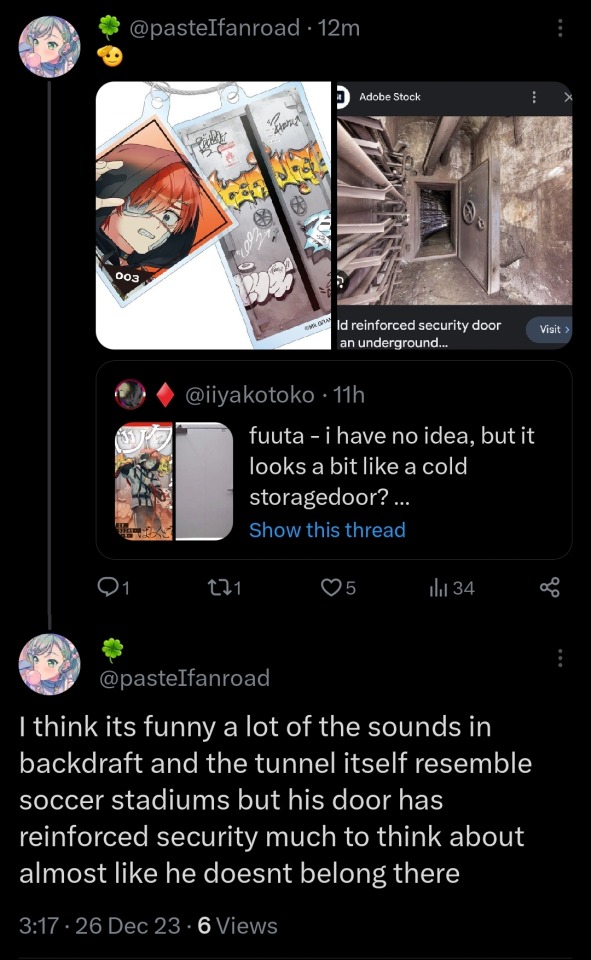
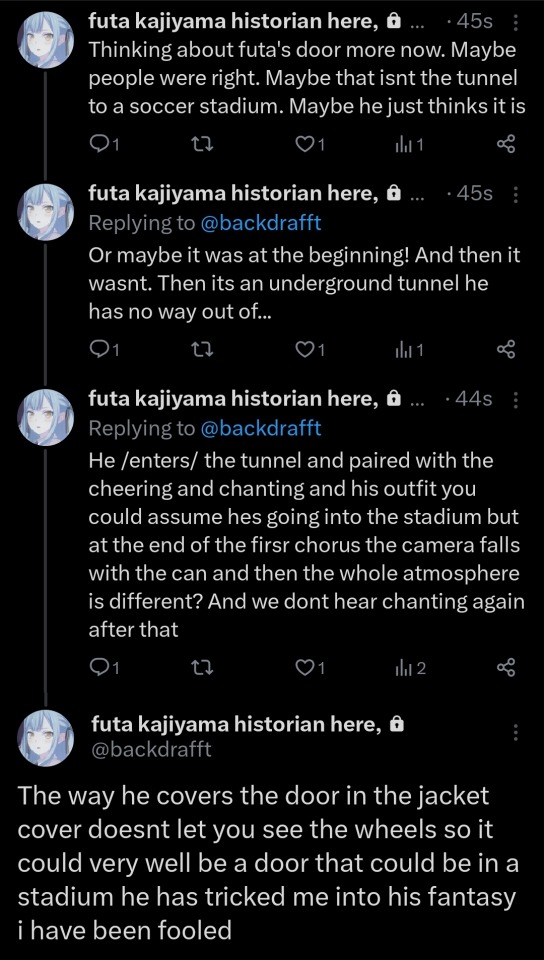
boy we have got to talk about this boy
To elaborate more on what this could mean, i think it could have something to do with the fact that futa felt himself part of his friendgroup (the team) because of all the things he did with them together (playing for the team) but they never really saw him as one of them nor did they care (he was barely substitute). It makes sense even looking at his outfit, soccer /players/ don't really dress like that on the field. The substitutes on the bench do
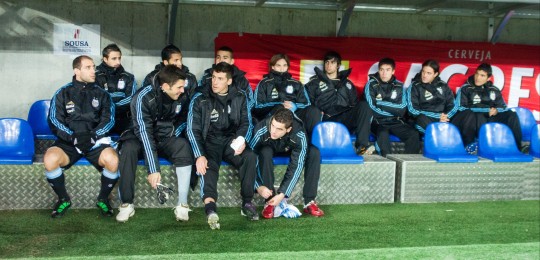
Backdraft constantly plays into his lack of belonging, even though all of his actions come from his own sense of belonging to the group. It wasn't reciprocated
Him entering a soccer stadium in substitute-like clothing but ending up in a dangerous, dark, neverending underground tunnel just further showcases how much he was NOT meant to reach the field with the rest of the team.
211 notes
·
View notes
Text
I figured out what train Mikoto takes in Double
But before I get into the meat of this, let me explain how I'm doing this post. First, I'll be going over the basics. I will be then going over everything that has been bolded.
There will be a part 2 to this post where I try to triangulate his actions through out MeMe.
So I started at Shibuya Station since the image on his mugshot board was taken in Shibuya.

I then narrowed it down to the Saikyō Line or the Yamanote Line. Both of which are standard commuter lines operated by JR East. So then I looked at what the trains look like and the train that is currently in use for the Yamanote Line looks almost identical to the one in Double.
The train that is currently in use is the E235 series which was first rolled out on November 30th 2015 and recalled the same day due to a number of issues including problems with door close indicators. It was later reintroduced on March 7th 2016. As of January 20th 2020, it has been the only type on train in service on the Yamanote Line.


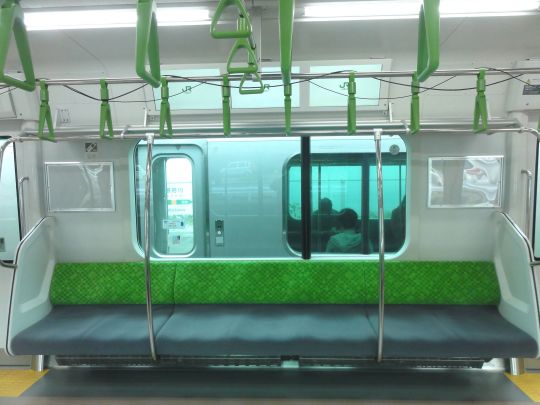



The line is known to be overcrowded due to being a circle and hitting all of the major locations in Tokyo. It starts and ends most commonly at Ōsaki Station in Shinagawa but can also start/stop at Ikebukuro Station in Toshima. Some trains start from Tamachi Station in Minato in the mornings and end at Shinagawa Station in Minato in the evenings. Trains run from 04:26 to 01:04 the next day and there are a total of 30 stations in the loop. The outside of the loop gose clockwise and the inside goes counter clockwise.
Yamanote roughly translates to foothills. After WW2, all of the train place cards were romanized, and because 山手 reads as Yamate, the line was mistranslated until the 70s.
All of the stations located in the Shibuya Ward are Ebisu, Shibuya, Harajuku and Yoyogi. Part of the line is shared with the Tōhoku and Tōkaidō Main Lines. From Tabata Station in Kita to Tōkyō Station in Chiyoda are shared by the Tōhoku Main Line. From Yūrakuchō Station in Chiyoda to Takanawa Gateway Station in Minato are shared by the Tōkaidō Main Line.

The line was first was opened on March 1st 1885, operating between Shinagawa Station in Minato and Akabane Station in Kita. The second part was opened on April 1st 1903, operating between Ikebukuro Station in Toshima and Tabata Station in Kita as a seperate line. On October 12th 1909, the 2 lines were merged, which created the present day Yamanote line. The full loop was completed in 1919 with the addition of Tōkyō Station in Chiyoda, and 1925 with the addition of Akihabara Station in Chiyoda.

The picture on his card is specifically from Ebisu. But the station seen in Double doesn't match up with the Yamanote Line platforms as they are island platforms, not side platforms. If he was at Ebisu Station, He would likely be at JR platform 1. This one is directed to Shibuya, Shinjuku and Ikebukuro. Shibuya only has island platforms and one of Yoyogi's and Harajuku's platforms are also islands. Out of the remaining platforms in the Shibuya portion of the line, Harajuku platform 2 looks the closest. It would also make sense that he would be in Harajuku due to his interests.
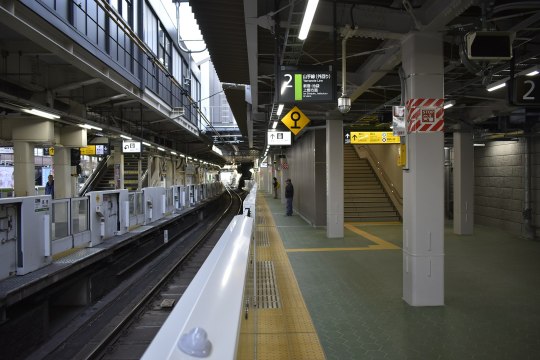

The line being a circle makes sense with the theme of Double; a never ending train that never stops. And the technical issues with the doors adds to this feeling of being trapped. The train also being overcrowded matches up with what it's like in the beginning of Double. However, the train soon is completely empty.
#milgram#ミルグラム#milgram project#mikoto kayano#kayano mikoto#milgram analysis#fools mate research#milgram theory
40 notes
·
View notes
Text
Potential symbolism on the prisoner's deaths
//Discussion of death and suicide
Tbh I am trying to think of some ways the manner the prisoners died relate to their character… This is just copypasted from what I said in a discord server with friends so if its phrased weirdly whoops Haruka- Starved himself to death, besides being the easiest option for him considering his restraints, I feel it could represent how for most of his life he had been starved from attention. Starvation in general can also be a sign of neglect especially when it comes to children.
Shidou- I guess I can say it would be related to what Shidou said to Esu that a child is appropiate to judge him because of his crime. Plus he asked for the death penalty multiple times. Idk I guess him being killed by a child is somewhat fitting in that aspect? Also if we are led to believe Amane used her scissors to murder Shidou, it would be oddly relevant, as scissors are heavy tied to Shidou, him using them a lot in Throw Down and being one of the symbols used to represent him. Mahiru- Died because of lack of attention you could say… she was someone who literally felt dead when she had no romantic connections with others. When the person who was taking care of her died, she soon followed, codependant till the end..
#milgram#milgram analysis#milgram theory#haruka sakurai#shidou kirisaki#mahiru shiina#death talk warning#idk
28 notes
·
View notes